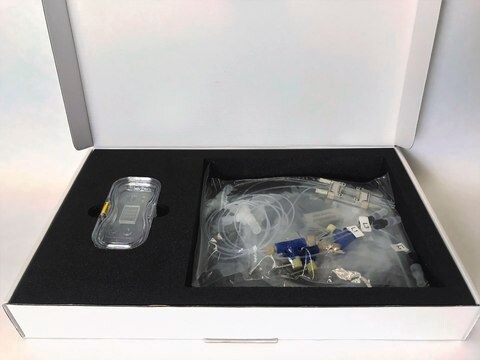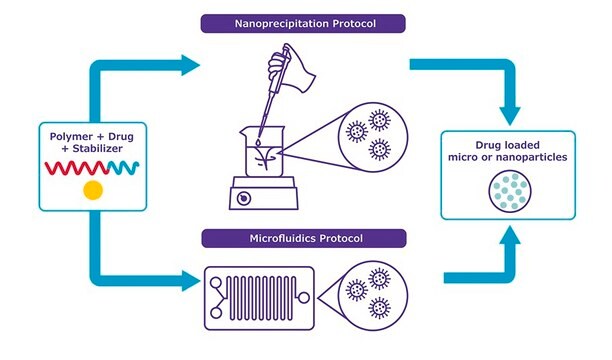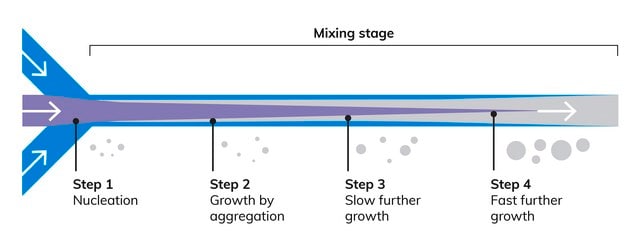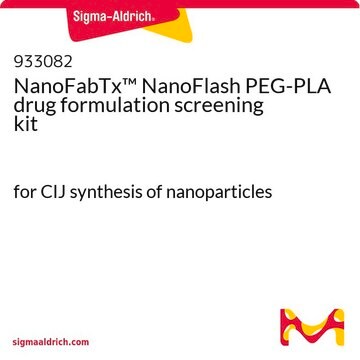추천 제품
설명
Kit components :
PEGPLA-L-M (919942-500mg)
PEGPLA-H-M (919934-500mg)
Stabilizer-Nano (907766-5g)
PEG-PLA drug formulation screening kit, for synthesis of PEGylated PLA nanoparticles
Quality Level
응용 분야
advanced drug delivery
저장 온도
2-8°C
일반 설명
NanoFabTx™ PEG-PLA drug formulation screening kit is a nanoformulation kit containing rationally selected PEGylated PLA polymers that have been used widely for controlled drug release of many different types of therapeutic molecules. The kit contains protocols for two different particle synthesis methods:
- A Nanoprecipitation protocol to prepare drug-encapsulated nanoparticles in standard laboratory glassware.
- A Microfluidics protocol using commercial platforms or syringe pumps.
애플리케이션
NanoFabTx™ PEG-PLA drug formulation screening kit enables users to encapsulate a wide variety of therapeutic drug molecules in specifically sized, biodegradable, PEGylated PLA nanoparticles. By simplifying the chemistry and providing an easy-to-use toolkit with step-by-step instructions, our NanoFabTx™ nanoformulation screening kit helps researchers achieve reproducible synthesis of drug encapsulating nanoparticles with narrow size dispersity, eliminating the need for lengthy trial-and-error optimization. Suitable for biomedical research applications such as oncology, immuno-oncology, gene delivery, and vaccine delivery, PEG-PLA nanoparticles, made using the NanoFabTx™ PEG-PLA drug formulation screening kit, are designed for maximizing the encapsulation of hydrophobic drugs to minimize the time and expensive wasted reagents of synthetic optimization.
특징 및 장점
- Includes tested protocols with step-by-step instructions for nanoprecipitation or microfluidics-based syntheses
- Requires minimal laboratory setup
- Optimized to achieve monodisperse, homogenously shaped, biodegradable, PEGylated PLA nanoparticles in any size between 60 and 100 nm
- Formulated to maximize the encapsulation of hydrophobic drugs
- Includes two different PEGylated PLAs
법적 정보
NANOFABTX is a trademark of Sigma-Aldrich Co. LLC
관련 제품
제품 번호
설명
가격
Storage Class Code
10 - Combustible liquids
가장 최신 버전 중 하나를 선택하세요:
Solène Passemard et al.
Biomacromolecules, 18(9), 2747-2755 (2017-07-26)
The production of hydrogel microspheres (MS) for cell immobilization, maintaining the favorable properties of alginate gels but presenting enhanced performance in terms of in vivo durability and physical properties, is desirable to extend the therapeutic potential of cell transplantation. A
Xu Jia et al.
ACS biomaterials science & engineering, 2(9), 1641-1648 (2016-09-12)
Theranostic nanomedicine has recently emerged as an appealing approach for tumor chemotherapy. Here, for the first time, fluorescent carbon dots (Cdots) were used as cross-linker for tumor theranostic nanoparticles. Novel theranostic nanoparticles of approximately 27 nm with a doxorubicin (DOX)
Redouan Mahou et al.
Materials (Basel, Switzerland), 7(1), 275-286 (2014-01-09)
The progress of medical therapies, which rely on the transplantation of microencapsulated living cells, depends on the quality of the encapsulating material. Such material has to be biocompatible, and the microencapsulation process must be simple and not harm the cells.
Sungmin Nam et al.
Biomaterials, 200, 15-24 (2019-02-12)
Hydrogels are commonly used as artificial extracellular matrices for 3D cell culture and for tissue engineering. Viscoelastic hydrogels with tunable stress relaxation have recently been developed, and stress relaxation in the hydrogels has been found to play a key role
S Freiberg et al.
International journal of pharmaceutics, 282(1-2), 1-18 (2004-09-01)
Polymer microspheres can be employed to deliver medication in a rate-controlled and sometimes targeted manner. Medication is released from a microsphere by drug leaching from the polymer or by degradation of the polymer matrix. Since the rate of drug release
자사의 과학자팀은 생명 과학, 재료 과학, 화학 합성, 크로마토그래피, 분석 및 기타 많은 영역을 포함한 모든 과학 분야에 경험이 있습니다..
고객지원팀으로 연락바랍니다.





